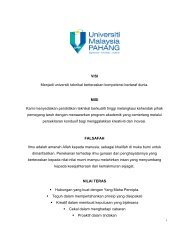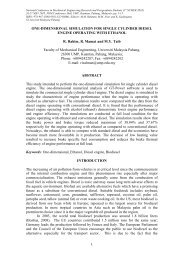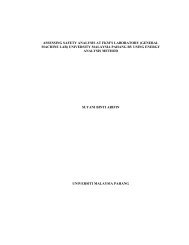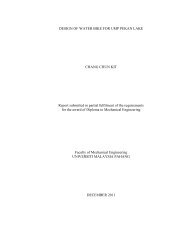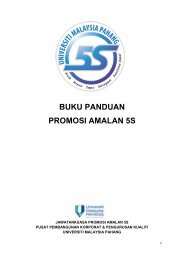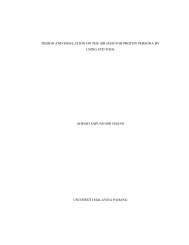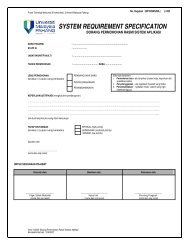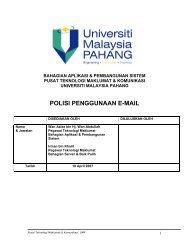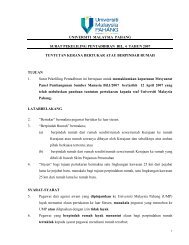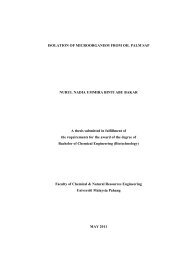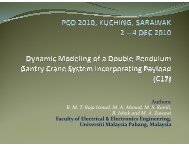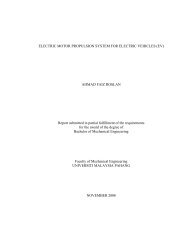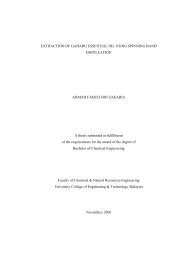implementation of quality tools in small medium industry - Universiti ...
implementation of quality tools in small medium industry - Universiti ...
implementation of quality tools in small medium industry - Universiti ...
Create successful ePaper yourself
Turn your PDF publications into a flip-book with our unique Google optimized e-Paper software.
IMPLEMENTATION OF QUALITY TOOLS IN SMALL MEDIUM INDUSTRYMIRZAN AIDIF BIN MOHD SHAKHIRA report <strong>in</strong> partial fulfillment <strong>of</strong> the requirements for the award <strong>of</strong> the degree <strong>of</strong>Bachelor <strong>of</strong> Mechanical Eng<strong>in</strong>eer<strong>in</strong>gFaculty <strong>of</strong> Mechanical Eng<strong>in</strong>eer<strong>in</strong>g<strong>Universiti</strong> Malaysia PahangNOVEMBER 2008
iiSUPERVISOR DECLARATION“We hereby declare that we have read this thesis and <strong>in</strong> our op<strong>in</strong>ion this thesis issufficient <strong>in</strong> terms <strong>of</strong> scope and <strong>quality</strong> for the award <strong>of</strong> the degree <strong>of</strong> Bachelor <strong>of</strong>Mechanical Eng<strong>in</strong>eer<strong>in</strong>g”Signature: ……………………………………..Name <strong>of</strong> Supervisor : MR MOHD FADZIL ABDUL RAHIMPosition: ……………………………………..Date : NOVEMBER 13 th , 2008SignatureName <strong>of</strong> panelPositionDate: ……………………………………..: ……………………………………..: ……………………………………..: ……………………………………..
iiiSTUDENT DECLARATIONI hereby declare that this thesis entitled “Implementation <strong>of</strong> Quality Tools In SmallMedium Industry” is the result <strong>of</strong> my own research except as cited <strong>in</strong> the references.The thesis has not been accepted for any degree and is not concurrently submitted <strong>in</strong>candidature <strong>of</strong> any other degree.Signature : ..........................................................Name: MIRZAN AIDIF BIN MOHD SHAKHIRID Number : MA 05022Date : NOVEMBER 13 th , 2008
Dedicated to my beloved Mother, Father, Sister and Brothersiv
vACKNOWLEDGEMENTSFirst I would like to express my grateful to ALLAH S.W.T. as for thebless<strong>in</strong>g given that I can f<strong>in</strong>ish my project. In prepar<strong>in</strong>g this paper, I have engagedwith many people <strong>in</strong> help<strong>in</strong>g me complet<strong>in</strong>g this project. First, I wish to express mys<strong>in</strong>cere appreciation to my ma<strong>in</strong> thesis supervisor Mr Mohd Fadzil Abdul Rahim, forencouragement, guidance, advices and motivation. Without his cont<strong>in</strong>ued supportand <strong>in</strong>terest, this thesis would not have been the same as presented here. Last but notleast I acknowledge without endless love and relentless support from my family, Iwould not have been here. Father, mother, sister and brothers, you all have given methe <strong>in</strong>spirations and encouragement until these days. Thank you all.
viABSTRACTQuality <strong>tools</strong> are one <strong>of</strong> the methods used to control and improve productivity bymany ways such as reduc<strong>in</strong>g the repetitive mistake. Quality plays such an importantrole <strong>in</strong> the manufactur<strong>in</strong>g <strong>in</strong>dustry <strong>in</strong> order to raise the pr<strong>of</strong>it <strong>of</strong> the company and alsothe company’s name. SMI has many problems <strong>in</strong> their company specifically <strong>in</strong> theprocess<strong>in</strong>g l<strong>in</strong>e. This is because they just focus<strong>in</strong>g <strong>in</strong> produc<strong>in</strong>g the products and nottak<strong>in</strong>g the lack occur <strong>in</strong> the process<strong>in</strong>g very well. This study is about to apply the<strong>quality</strong> <strong>tools</strong> <strong>in</strong> the process<strong>in</strong>g l<strong>in</strong>e <strong>in</strong> order to identify where the highest waste isoccur at and to give suggestion for improvement at the major waste <strong>in</strong>volves <strong>in</strong> theprocess<strong>in</strong>g l<strong>in</strong>e. The selected SMI is produc<strong>in</strong>g spice which is one <strong>of</strong> important<strong>in</strong>gredients <strong>in</strong> Malaysian food. There are four stages for produc<strong>in</strong>g spice, weigh<strong>in</strong>g,roast<strong>in</strong>g, gr<strong>in</strong>d<strong>in</strong>g and packag<strong>in</strong>g. Due to the <strong>in</strong>terview there are two causescontribute to waste, which are roast<strong>in</strong>g and gr<strong>in</strong>d<strong>in</strong>g process. From the data taken andthe analysis done, it shows the highest waste occur <strong>in</strong> the gr<strong>in</strong>d<strong>in</strong>g process whichcause by four factors, expose to the mov<strong>in</strong>g fan, spices stick at the gr<strong>in</strong>d blade,rotat<strong>in</strong>g gear and tupperware without lid. This shows that <strong>quality</strong> <strong>tools</strong> managed t<strong>of</strong><strong>in</strong>d the highest waste occur <strong>in</strong> the process<strong>in</strong>g l<strong>in</strong>e. The company can reduce thewaste by put on the lid on the table used for cool<strong>in</strong>g the spice, service the gr<strong>in</strong>d<strong>in</strong>gblade once after runn<strong>in</strong>g three time to avoid the wet spices will attract more spices tostick together, build a compartment at the rotat<strong>in</strong>g gear as obstacle and put on the lidon the tupperware to ensure the spice will not gett<strong>in</strong>g away from the tupperware.
viiABSTRAKPerkakas kualiti merupakan salah satu kaedah digunakan untuk mengawal danmenigkatkan produktiviti dengan banyak cara antaranya mengurangkan kesilapanyang berulang. Kualiti mema<strong>in</strong>kan peranan pent<strong>in</strong>g bagi syarikat pembuatan untukmen<strong>in</strong>gkatkan keuntungan dan menaikkan nama syarikat. SSK mempunyai banyakmasalah di dalam syarikat mereka terutamanya di bahagian pemprosessan. Ini adalahkerana mereka hanya fokus dalam penghasilan produk dan tidak mengambilkekurangan di bahagian pemprosessan dengan baik. Pengkajian <strong>in</strong>i adalah tentangmenggunakan perkakas kualiti di bahagian pemprosessan untuk mencari dimanakahberlakunya pembaziran yang tert<strong>in</strong>ggi dan untuk memberi cadangan bagimen<strong>in</strong>gkatkan kawasan pembaziran major yang terlibat. SSK yang terpilihmenghasilkan rempah yang mana merupakan salah satu ramuan yang pent<strong>in</strong>g dalammasakan orang Malaysia. Ada empat perigkat bagi menghasilkan rempah, timbangberat, panggang, mengisar dan mempaket. Berdasarkan temubual ada dua penyebabyang menyumbangkan pembaziran, yang mana adalah panggang dan mengisar.Daripada data yang diambil dan analisis yang dijalankan, ia menunjukkanpembaziran yang tert<strong>in</strong>ggi berlaku di proses mengisar yang mana disebabkan olehempat faktor, terdedah kepada kipas yang bergerak, rempah melekat pada matapengisar, gear yang berpus<strong>in</strong>g dan bekas tanpa penutup. Ini menunjukkan perkakaskualiti berjaya mencari pembaziran tert<strong>in</strong>ggi yang berlaku di bahagian pemprosessan.Syarikat tersebut boleh mengurangkan pembaziran dengan meletakkan penutup padameja yang digunakan untuk menyejukkan rempah, servis mata pengisar sekaliselepas menggunakan tiga kali untuk mengelakkan rempah yang lembab menariklebih banyak rempah yang melekat, memb<strong>in</strong>a pengkotak pada gear yang bergeraksebagai penghalang dan meletakkan penutup pada bekas bagi mengelakkan rempahterkeluar.
viiiTABLE OF CONTENTSPageTITLE PAGE iSUPERVISOR DECLARATION iiSTUDENT DECLARATIONiiiDEDICATIONivACKNOWLEGDEMENTS vABSTRACTviABSTRAKviiTABLE OF CONTENTS viiiLIST OF TABLESxiLIST OF FIGURES xiiiCHAPTER 1 INTRODUCTION1.1 Project background 11.2 Why SMI 21.3 Scope <strong>of</strong> Project 21.4 Problem Statement 31.5 Objective 3CHAPTER 2LITERATURE REVIEW2.1 Def<strong>in</strong>ition <strong>of</strong> Quality 42.2. Seven Basic Quality Tools 52.2.1 Check sheet 52.2.2 Pareto chart 62.2.2.1 Weight Pareto chart 72.2.3 Cause and effect diagram 92.2.4Conclusion <strong>of</strong> Seven Basic Quality Tools 102.3 Implementation <strong>of</strong> Quality Tools <strong>in</strong> previous case 102.3.1 Seven Basic Quality Tools (Pareto chart) 10
ixCHAPTER 3METHODOLOGY3.1 Introduction 123.2 Literature Review on the topic 123.3 Def<strong>in</strong>e the objective, scopes and problem statement 123.4 F<strong>in</strong>d the <strong>small</strong> <strong>medium</strong> <strong>in</strong>dustry 133.5 Interview 133.5.1 Important f<strong>in</strong>d<strong>in</strong>g from the <strong>in</strong>terview 163.6 F<strong>in</strong>d the major defects and start tak<strong>in</strong>g data 163.7 Analysis 193.8 Conclusion 193.9 Chapter summary 20CHAPTER 4RESULTS AND DISCUSSION4.1 Introduction 214.2 Results 214.2.1 Results <strong>of</strong> 10 random spices 214.2.2 Results <strong>of</strong> 3 Kurma spice 254.2.2.1 Data 1 254.2.2.2 Data 2 264.2.2.3 Data 3 284.3 Important f<strong>in</strong>d<strong>in</strong>g from 3 data taken 294.4 Discussion 304.4.1 Expose to w<strong>in</strong>d (fan) 304.4.2 Spices stick at the gr<strong>in</strong>d<strong>in</strong>g blade 314.4.3 Tupperware without lid 334.4.4 Rotat<strong>in</strong>g gear 344.5 Suggestion for improvement 354.5.1 Case 1; Expose to w<strong>in</strong>d (fan) 354.5.2 Case2; Spices stick at the gr<strong>in</strong>d<strong>in</strong>g blade 374.5.3 Case 3; Tupperware without the lid 374.5.4 Case 4; Rotat<strong>in</strong>g gear 38
xCHAPTER 5CONCLUSION AND RECOMMENDATIONS5.1 Conclusion 415.2 Recommendation 41REFERENCES 42APPENDICESAppendix A Interview 43Appendix B Check sheet <strong>of</strong> 10 random spices and Kurma spice 44-46Appendix C Data <strong>of</strong> 10 random spices and Kurma spice 47-50Appendix D Gantt chart <strong>of</strong> PSM 1 and PSM 2 51-53
xiLIST OF TABLESTable No. Title Page3.1 Check Sheet for tak<strong>in</strong>g <strong>of</strong> 10 random spices 173.2 Check sheet for tak<strong>in</strong>g 3 data <strong>of</strong> the selected spice 174.1 Data for Beriani spice, Kari Dag<strong>in</strong>g, Opor spice, 22Kurma spice and Nasi Dagang4.2 Data for Satay spice, Soto spice, Gulai Kawah, Kari Ikan 22and Rendang4.3 Data <strong>of</strong> waste dur<strong>in</strong>g the process <strong>in</strong> kilogram (kg) for 22Beriani spice, Kari Dag<strong>in</strong>g, Opor spice, Kurma spiceand Nasi Dagang4.4 Data <strong>of</strong> waste dur<strong>in</strong>g the process <strong>in</strong> kilogram (kg) for 23Satay spice, Soto spice, Gulai Kawah, Kari Ikanand Rendang4.5 Data <strong>of</strong> waste dur<strong>in</strong>g the process <strong>in</strong> percentage (%) for 23Beriani spice, Kari Dag<strong>in</strong>g, Opor spice, Kurma spiceand Nasi Dagang.4.6 Data <strong>of</strong> waste dur<strong>in</strong>g the process <strong>in</strong> percentage (%) for 23Satay spice, Soto spice, Gulai Kawah, Kari Ikanand Rendang4.7 Data 1 for Kurma spice 254.8 Waste dur<strong>in</strong>g the process (data 1) 25
xii4.9 Data 2 for Kurma spice 264.10 Waste dur<strong>in</strong>g the process (data 2) 274.11 Data 3 for Kurma spice 284.12 Waste dur<strong>in</strong>g the process (data 3) 28
xiiiLIST OF FIGURESFigure No. Title Page2.1 Because it clearly organize data, check sheet is 6the easiest way to track <strong>in</strong>formation2.2 Typically the left y-axis is frequency <strong>of</strong> occurrence, 7and the right y-axis is the cumulative percentage <strong>of</strong> thetotal number <strong>of</strong> occurrence.2.3 The most frequently occurr<strong>in</strong>g defects are wr<strong>in</strong>kles 8and sta<strong>in</strong>s. Based just on this <strong>in</strong>formation, it can decideto develop and improvement project and around reduc<strong>in</strong>gwr<strong>in</strong>kles and stra<strong>in</strong>s.on weld hardness2.4 The most costly defects are scratches and dirt specs. Based 8on this more <strong>in</strong>formative data, it can decide that it is betterto develop an improvement project to reduce scratches anddirt specs.2.5 Fish bone diagrams display the various possible causes <strong>of</strong> 9the f<strong>in</strong>al effect. Further analysis can prioritize them.2.6 Pareto chart <strong>of</strong> gr<strong>in</strong>d<strong>in</strong>g operations problems. 113.1 PJ FOOD Industries 133.2 Flowchart <strong>of</strong> process<strong>in</strong>g spices 143.3 Weigh<strong>in</strong>g process 143.4 Roast<strong>in</strong>g process 153.5 Gr<strong>in</strong>d<strong>in</strong>g process 15
xiv3.6 Packag<strong>in</strong>g process 163.7 Flowchart <strong>of</strong> methodology 204.1 Graph shows the waste value <strong>in</strong> roast<strong>in</strong>g and gr<strong>in</strong>d<strong>in</strong>g 24process4.2 Pareto Chart <strong>of</strong> Defects (Data 1) 264.3 Pareto Chart <strong>of</strong> Defects (Data 2) 274.4 Pareto Chart <strong>of</strong> Defects (Data 3) 294.5 Fish bone diagram <strong>of</strong> causes waste <strong>in</strong> gr<strong>in</strong>d<strong>in</strong>g process 304.6 Spices expose to the mov<strong>in</strong>g fan 304.7 Spices stick at the gr<strong>in</strong>d<strong>in</strong>g blade (front view) 314.8 Spices stick at the gr<strong>in</strong>d<strong>in</strong>g blade (top view) 314.9 Spices stick at the gr<strong>in</strong>d<strong>in</strong>g compartment 324.10 Spices stick at the gr<strong>in</strong>d<strong>in</strong>g mach<strong>in</strong>e 334.11 The spices move out from the tupperware 334.12 The rotat<strong>in</strong>g gear 344.13 Spices stick at the gr<strong>in</strong>d<strong>in</strong>g mach<strong>in</strong>e 354.14 Top view <strong>of</strong> the table 36
xv4.15 Cross section <strong>of</strong> the lid 364.16 Top view <strong>of</strong> the tupperware lid 374.17 Top view <strong>of</strong> the gear compartment 384.18 Side view <strong>of</strong> the gear compartment 394.19 Front view <strong>of</strong> the gear compartment 39
CHAPTER 1INTRODUCTION1.1 BackgroundQuality <strong>tools</strong> are the methods use to analyze and improv<strong>in</strong>g products. One <strong>of</strong>the objectives <strong>of</strong> <strong>quality</strong> <strong>tools</strong> is less variation <strong>in</strong> the product. The phrase lessvariation is a relative one. Less than a product that has more variation. To create a<strong>quality</strong> product, we m<strong>in</strong>imize the variation <strong>in</strong> the specification <strong>of</strong> the product. Thus<strong>quality</strong> also could mean reliability. This implies that <strong>quality</strong> product tend to be morereliable. Quality has several major bus<strong>in</strong>ess advantages. Some <strong>of</strong> them are <strong>quality</strong>builds customer loyalty, pr<strong>of</strong>its marg<strong>in</strong>s can be susta<strong>in</strong>ed, plus a better impressionhelps expand the customer base. In the long run, <strong>quality</strong> will reduce the operat<strong>in</strong>gcosts and <strong>in</strong>crease pr<strong>of</strong>its. Quality also means larger bus<strong>in</strong>ess pr<strong>of</strong>it as the companycan elim<strong>in</strong>ate or reduce waste. There is a great deal <strong>of</strong> pr<strong>of</strong>it to make by <strong>quality</strong>improvements <strong>in</strong> products and services, bus<strong>in</strong>ess processes and people. The purpose<strong>of</strong> <strong>quality</strong> management is to set up a <strong>quality</strong> and management discipl<strong>in</strong>e that preventsdefects from happen<strong>in</strong>g <strong>in</strong> company’s performance cycle. To accomplish this, acompany has to act now <strong>in</strong> situations that may cause problems later. Quality must bemeasured <strong>in</strong> order to manage it. The company must measure the results <strong>of</strong> how everypart <strong>of</strong> their company is do<strong>in</strong>g at provid<strong>in</strong>g <strong>in</strong>ternal and external customers with whatthey want. Whatever measure they choose should work for each department so thatthey can understand and asses the impact <strong>of</strong> <strong>in</strong>dividual decisions on the company asthe whole and on their customers. The place that has related with this topic is exactly<strong>in</strong> <strong>in</strong>dustries field. This is because every product the companies’ produc<strong>in</strong>g is alwaysconnect<strong>in</strong>g with the customers, who buy and use it. In order for becom<strong>in</strong>g superbranded goods, the companies need to have the characteristics <strong>of</strong> customer’sdemands and requirements <strong>in</strong> order to satisfy the customer. [Shah, 2004]
21.2 Why SMISMI stands for Small Medium Industry. Even though some <strong>of</strong> SMI is alreadyold <strong>in</strong> the <strong>in</strong>dustry but this company have such problem and difficulties which arestill unsolved such as the improper environment <strong>of</strong> work<strong>in</strong>g area, cont<strong>in</strong>uous waste <strong>in</strong>the process<strong>in</strong>g area and etc. These situations occur because there is no pr<strong>of</strong>essionalposition <strong>in</strong> the company. such as an eng<strong>in</strong>eer to monitor and solve problems <strong>in</strong> theprocess<strong>in</strong>g l<strong>in</strong>e. All <strong>of</strong> the employees are consist <strong>of</strong> non educational people. Thiscompany also have limitation budget. The company just wants the effective methodwith the low cost to overcome the problem.1.3 Scope <strong>of</strong> the projectThis project is about to implement the <strong>quality</strong> <strong>tools</strong> <strong>in</strong> the selected SMI. Theselected SMI is PJ FOOD which located at Kuantan, Pahang. The company isproduc<strong>in</strong>g spices, which is one <strong>of</strong> the most important <strong>in</strong>gredients <strong>in</strong> Malaysian food.The study is focus<strong>in</strong>g <strong>in</strong> the process<strong>in</strong>g l<strong>in</strong>e. There are four stages <strong>in</strong> the process<strong>in</strong>gl<strong>in</strong>e which are <strong>in</strong>clud<strong>in</strong>g weight measur<strong>in</strong>g, roast<strong>in</strong>g, gr<strong>in</strong>d<strong>in</strong>g and packag<strong>in</strong>g.Accord<strong>in</strong>g to the observation, the f<strong>in</strong>al weight produces after all the processes are notexactly or approximately to the expectation value, which is less than expected.Quality <strong>tools</strong> will be implement <strong>in</strong> the process<strong>in</strong>g l<strong>in</strong>e <strong>of</strong> this SMI <strong>in</strong> order to f<strong>in</strong>dwhere the highest waste is occur at what process area, among those processes. Thisproposal will give such a comprehensive ideas on how to reduce the waste by f<strong>in</strong>d<strong>in</strong>gand analyz<strong>in</strong>g the causes occurs <strong>in</strong> the process<strong>in</strong>g l<strong>in</strong>e.
31.4 Problem statementi. In order to reduce waste <strong>in</strong> process<strong>in</strong>g l<strong>in</strong>e major defect must be identify andmeasure at first. The most significant root <strong>of</strong> waste need to be elim<strong>in</strong>ated.ii. Process<strong>in</strong>g l<strong>in</strong>e <strong>of</strong> food production is needed to be study and analyze.1.5 Objectivei. To identify and suggest improvement for the major defects <strong>in</strong>volve <strong>in</strong> theprocess<strong>in</strong>g l<strong>in</strong>e.ii. To applied the <strong>quality</strong> <strong>tools</strong> <strong>in</strong> process<strong>in</strong>g l<strong>in</strong>e.
4CHAPTER 2LITERATUREVIEW2.1 Def<strong>in</strong>ition <strong>of</strong> <strong>quality</strong>Quality is def<strong>in</strong>ed as a degree or grade <strong>of</strong> the excellence <strong>of</strong> the product. In themanufactur<strong>in</strong>g <strong>in</strong>dustry it is commonly stated that “Quality drives productivity.”Improved productivity is a source <strong>of</strong> greater revenues, employment opportunities andtechnological advances. Objective <strong>of</strong> <strong>quality</strong> is to compliance <strong>of</strong> a process or itsoutcome with a predeterm<strong>in</strong>ed set <strong>of</strong> criteria, which are presumed essential to theultimate value it provides. Quality means less variation <strong>in</strong> the product. The phraseless variation is a relative one. Less than a product that has more variation. To createa <strong>quality</strong> product, we m<strong>in</strong>imize the variation <strong>in</strong> the specification <strong>of</strong> the product. Thus<strong>quality</strong> also could mean reliability. This implies that <strong>quality</strong> product tend to be morereliable. Quality has several major bus<strong>in</strong>ess advantages. Some <strong>of</strong> them are <strong>quality</strong>builds customer loyalty, pr<strong>of</strong>its marg<strong>in</strong>s can be susta<strong>in</strong>ed, plus a better impressionhelps expand the customer base. In the long run, <strong>quality</strong> will reduce the operat<strong>in</strong>gcosts and <strong>in</strong>crease pr<strong>of</strong>its. Quality also means larger bus<strong>in</strong>ess pr<strong>of</strong>it as themanufacturer can elim<strong>in</strong>ate or reduce waste. Quality is also demand<strong>in</strong>g, difficult,never end<strong>in</strong>g effort to improve worse. There is a great deal <strong>of</strong> pr<strong>of</strong>it to make by<strong>quality</strong> improvements <strong>in</strong> products and services, bus<strong>in</strong>ess processes and people. Thepurpose <strong>of</strong> <strong>quality</strong> management is to set up a <strong>quality</strong> and management discipl<strong>in</strong>e thatprevents defects from happen<strong>in</strong>g <strong>in</strong> manufacturer’s performance cycle. Toaccomplish this, a manufacturer has to act now <strong>in</strong> on situations that may causeproblems later. Quality must be measured <strong>in</strong> order to manage it. The manufacturermust measure the results <strong>of</strong> how every part <strong>of</strong> their company is do<strong>in</strong>g at provid<strong>in</strong>g<strong>in</strong>ternal and external customers with what they want. [Juran and Godfrey, 1999]
52.2 Seven basic <strong>quality</strong> <strong>tools</strong>Once the basic problem-solv<strong>in</strong>g or <strong>quality</strong> improvement process isunderstood, the addition <strong>of</strong> <strong>quality</strong> <strong>tools</strong> can make the process proceed more quicklyand systematically. Seven simple <strong>tools</strong> can be used by any pr<strong>of</strong>essional to ease the<strong>quality</strong> improvement process: flowcharts, check sheets, Pareto diagrams, cause andeffect diagrams, histograms, scatter diagrams, and control charts. (Some booksdescribe a graph <strong>in</strong>stead <strong>of</strong> a flowchart as one <strong>of</strong> the seven <strong>tools</strong>).The concept beh<strong>in</strong>d the seven basic <strong>tools</strong> came from Kaoru Ishikawa, arenowned <strong>quality</strong> expert from Japan. Accord<strong>in</strong>g to Ishikawa, 95% <strong>of</strong> <strong>quality</strong>-relatedproblems can be resolved with these basic <strong>tools</strong>. The key to successful problemresolution is the ability to identify the problem, use the appropriate <strong>tools</strong> based on thenature <strong>of</strong> the problem, and communicate the solution quickly to others.Inexperienced personnel might do best by start<strong>in</strong>g with the Pareto chart and the causeand effect diagram before tackl<strong>in</strong>g the use <strong>of</strong> the other <strong>tools</strong>. Those two <strong>tools</strong> areused most widely by <strong>quality</strong> improvement teams. [Gitlow, Oppenheim, Lev<strong>in</strong>e,2005]2.2.1 Check sheetCheck sheets help organize data by category. They show how many timeseach particular value occurs, and their <strong>in</strong>formation is <strong>in</strong>creas<strong>in</strong>gly helpful as moredata are collected. More than 50 observations should be available to be charted forthis tool to be really useful. Check sheets m<strong>in</strong>imize clerical work s<strong>in</strong>ce the operatormerely adds a mark to the tally on the prepared sheet rather than writ<strong>in</strong>g out a figure(Figure 2.1). By show<strong>in</strong>g the frequency <strong>of</strong> a particular defect (e.g., <strong>in</strong> a molded part)and how <strong>of</strong>ten it occurs <strong>in</strong> a specific location, check sheets help operators spotproblems. The check sheet example shows a list <strong>of</strong> molded part defects on aproduction l<strong>in</strong>e cover<strong>in</strong>g a week's time. One can easily see where to set prioritiesbased on results shown on this check sheet. Assum<strong>in</strong>g the production flow is thesame on each day, the part with the largest number <strong>of</strong> defects carries the highestpriority for correction.
6Figure 2.1.Because it clearly organizes data, a check sheet is the easiest way to track<strong>in</strong>formation.2.2.2 Pareto chartPareto Chart is a special type <strong>of</strong> bar chart where the plotted values arearranged from largest to <strong>small</strong>est. A Pareto chart is used to highlight the mostfrequently occurr<strong>in</strong>g defects, the most common causes <strong>of</strong> defects, or the mostfrequent causes <strong>of</strong> customer compla<strong>in</strong>ts.The Pareto chart is named for Vilfredo Pareto and his pr<strong>in</strong>ciple <strong>of</strong> the "80/20rule." That is, 20% <strong>of</strong> the people conta<strong>in</strong> 80% <strong>of</strong> the wealth; or 20% <strong>of</strong> the productl<strong>in</strong>e may generate 80% <strong>of</strong> the waste; or 20% <strong>of</strong> the customers may generate 80% <strong>of</strong>the compla<strong>in</strong>ts, etc.For example, the hotel management wants to <strong>in</strong>vestigate causes <strong>of</strong> customerdissatisfaction at your hotel cha<strong>in</strong> so <strong>in</strong>vestigate and record customer reasons fortheir compla<strong>in</strong>ts.
7250Pareto chart <strong>of</strong> Compla<strong>in</strong>tsCounts200150100100806040Percent50200Conpla<strong>in</strong>ts room appliances cleanl<strong>in</strong>ess comfort OtherCounts 100 50 50 15 7Percent 45.0 22.5 22.5 6.8 3.2Cum % 45.0 67.6 90.1 96.8 100.00Figure 2.2.Typically the left y-axis is frequency <strong>of</strong> occurrence, and the right y-axis isthe cumulative percentage <strong>of</strong> the total number <strong>of</strong> occurrences.The x-axis displays the categories <strong>of</strong> defects, compla<strong>in</strong>ts, waste, etc.2.2.2.1 Weighted Pareto ChartA weighted Pareto chart not only considers the frequency <strong>of</strong> occurrence, butthe importance as well. A weighted Pareto chart can account for the severity <strong>of</strong> thedefects, or the cost, or anyth<strong>in</strong>g else you would like to track. For example, supposeyou have 5 coat<strong>in</strong>g defects that you are track<strong>in</strong>g: wr<strong>in</strong>kles, sta<strong>in</strong>s, scratches, dirtspecs, and bubbles.Collect data on the frequency <strong>of</strong> defect occurrence and the cost to rework. Aweighted Pareto chart may change your priority for improvement projects byconsider<strong>in</strong>g data based on both cost and frequency data. For example, even thoughwr<strong>in</strong>kles may be more frequent they are less expensive to fix than dirt specs, whichare a rarer occurrence. Consider<strong>in</strong>g both cost and frequency will give you a betterunderstand<strong>in</strong>g <strong>of</strong> your cost <strong>of</strong> poor <strong>quality</strong> (COPQ).
84 0 0P a r e t o c h a r t o f D e f e c t s1 0 03 0 08 0Frequency2 0 06 04 0Percent1 0 02 00D e fe c ts w r <strong>in</strong> k le s s ta <strong>in</strong> s s c r a tc h e s d ir t s p e c b u b le sF r e q u e n c y 1 0 0 9 0 8 0 5 0 3 0P e r c e n t 2 8 . 6 2 5 .7 2 2 .9 1 4 .3 8 .6C u m % 2 8 . 6 5 4 .3 7 7 .1 9 1 .4 1 0 0 .00Figure 2.3.The most frequently occurr<strong>in</strong>g defects are wr<strong>in</strong>kles and sta<strong>in</strong>s. Based juston this <strong>in</strong>formation, it can decide to develop an improvement project around reduc<strong>in</strong>gwr<strong>in</strong>kles and sta<strong>in</strong>s [Gitlow, Oppenheim, Lev<strong>in</strong>e, 2005]Pareto chart <strong>of</strong> Defects120001000010080Cost8000600040006040Percent2000200Defects scratches dirt spec sta<strong>in</strong>s bubbles 1600Cost 4000 2400 2000 1800 1600Percent 33.9 20.3 16.9 15.3 13.6Cum % 33.9 54.2 71.2 86.4 100.00Figure 2.4.The most costly defects are scratches and dirt specs. Based on this more<strong>in</strong>formative data, it can decide that it is better to develop an improvement project toreduce scratches and dirt specs [Gitlow, Oppenheim, Lev<strong>in</strong>e, 2005]
92.2.3 Cause and effect diagramThe cause and effect diagram is sometimes called an Ishikawa diagram afterits <strong>in</strong>ventor. It is also known as a fish bone diagram because <strong>of</strong> its shape. A cause andeffect diagram describes a relationship between variables. The undesirable outcomeis shown as effect, and related causes are shown as lead<strong>in</strong>g to, or potentially lead<strong>in</strong>gto, the said effect. This popular tool has one severe limitation, however, <strong>in</strong> that userscan overlook important, complex <strong>in</strong>teractions between causes. Thus, if a problem iscaused by a comb<strong>in</strong>ation <strong>of</strong> factors, it is difficult to use this tool to depict and solveit.A fish bone diagram displays all contribut<strong>in</strong>g factors and their relationships tothe outcome to identify areas where data should be collected and analyzed. Themajor areas <strong>of</strong> potential causes are shown as the ma<strong>in</strong> bones, e.g., materials,methods, people, measurement, mach<strong>in</strong>es, and design (Figure 2.5). Later, thesubareas are depicted. Thorough analysis <strong>of</strong> each cause can elim<strong>in</strong>ate causes one byone, and the most probable root cause can be selected for corrective action.Quantitative <strong>in</strong>formation can also be used to prioritize means for improvement,whether it is to mach<strong>in</strong>e, design, or operator.Figure 2.5.Fish bone diagrams display the various possible causes <strong>of</strong> the f<strong>in</strong>al effect.Further analysis can prioritize them
102.2.4 Conclusion <strong>of</strong> 7 Basic Quality ToolsMany people <strong>in</strong> the medical device manufactur<strong>in</strong>g <strong>in</strong>dustry are undoubtedlyfamiliar with many <strong>of</strong> these <strong>tools</strong> and know their application, advantages, andlimitations. However, manufacturers must ensure that these <strong>tools</strong> are <strong>in</strong> place andbe<strong>in</strong>g used to their full advantage as part <strong>of</strong> their <strong>quality</strong> system procedures.Flowcharts and check sheets are most valuable <strong>in</strong> identify<strong>in</strong>g problems, whereascause and effect diagrams, histograms, scatter diagrams, and control charts are usedfor problem analysis. Pareto diagrams are effective for both areas. By properly us<strong>in</strong>gthese <strong>tools</strong>, the problem-solv<strong>in</strong>g process can be more efficient and more effective.Those manufacturers who have mastered the seven basic <strong>tools</strong> described heremay wish to further ref<strong>in</strong>e their <strong>quality</strong> improvement processes. A future article willdiscuss seven new <strong>tools</strong>: relations diagrams, aff<strong>in</strong>ity diagrams (K-J method),systematic diagrams, matrix diagrams, matrix data diagrams, process decisionprograms, and arrow diagrams. These seven <strong>tools</strong> are used less frequently and aremore complicated.2.3 Implementation <strong>of</strong> the Quality <strong>tools</strong> <strong>in</strong> previous case2.3.1 Seven Basic <strong>of</strong> Quality Tools (Pareto chart)Statistical Th<strong>in</strong>k<strong>in</strong>g to Improve Quality <strong>of</strong> Mach<strong>in</strong><strong>in</strong>gThe application <strong>of</strong> Pareto chart <strong>in</strong> a case study from Gijo (2005). A companywas experienc<strong>in</strong>g a high rejection rate <strong>in</strong> one <strong>of</strong> its mach<strong>in</strong><strong>in</strong>g shops. They did notknow the root causes <strong>of</strong> these rejections nor how to reduce their occurrence. Theystarted by exam<strong>in</strong><strong>in</strong>g exist<strong>in</strong>g records and constructed a Pareto chart. The follow<strong>in</strong>gfigure presents the chart.
11Figure 2.6.Pareto chart <strong>of</strong> gr<strong>in</strong>d<strong>in</strong>g operation problems [Gijo, 2005]The chart shows that 60% <strong>of</strong> the rejections were due to gr<strong>in</strong>d<strong>in</strong>g problems. Basedon the Pareto Chart they started a study improve gr<strong>in</strong>d<strong>in</strong>g operations. This studyresulted <strong>in</strong> designed experiments to determ<strong>in</strong>e improved gr<strong>in</strong>d<strong>in</strong>g operat<strong>in</strong>gprocedures. The result<strong>in</strong>g analyses lead to operat<strong>in</strong>g procedures that significantlyreduc<strong>in</strong>g rejections and rework due to gr<strong>in</strong>d<strong>in</strong>g operations [Gijo, 2005]



